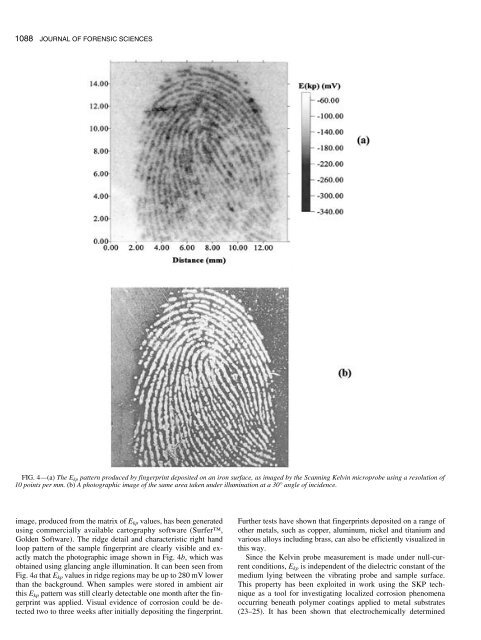Latent fingerprint detection using a scanning Kelvin ... - Library
Latent fingerprint detection using a scanning Kelvin ... - Library
Latent fingerprint detection using a scanning Kelvin ... - Library
You also want an ePaper? Increase the reach of your titles
YUMPU automatically turns print PDFs into web optimized ePapers that Google loves.
1088 JOURNAL OF FORENSIC SCIENCES<br />
FIG. 4—(a) The Ekp pattern produced by <strong>fingerprint</strong> deposited on an iron surface, as imaged by the Scanning <strong>Kelvin</strong> microprobe <strong>using</strong> a resolution of<br />
10 points per mm. (b) A photographic image of the same area taken under illumination at a 30° angle of incidence.<br />
image, produced from the matrix of Ekp values, has been generated<br />
<strong>using</strong> commercially available cartography software (Surfer,<br />
Golden Software). The ridge detail and characteristic right hand<br />
loop pattern of the sample <strong>fingerprint</strong> are clearly visible and exactly<br />
match the photographic image shown in Fig. 4b, which was<br />
obtained <strong>using</strong> glancing angle illumination. It can been seen from<br />
Fig. 4a that Ekp values in ridge regions may be up to 280 mV lower<br />
than the background. When samples were stored in ambient air<br />
this Ekp pattern was still clearly detectable one month after the <strong>fingerprint</strong><br />
was applied. Visual evidence of corrosion could be detected<br />
two to three weeks after initially depositing the <strong>fingerprint</strong>.<br />
Further tests have shown that <strong>fingerprint</strong>s deposited on a range of<br />
other metals, such as copper, aluminum, nickel and titanium and<br />
various alloys including brass, can also be efficiently visualized in<br />
this way.<br />
Since the <strong>Kelvin</strong> probe measurement is made under null-current<br />
conditions, Ekp is independent of the dielectric constant of the<br />
medium lying between the vibrating probe and sample surface.<br />
This property has been exploited in work <strong>using</strong> the SKP technique<br />
as a tool for investigating localized corrosion phenomena<br />
occurring beneath polymer coatings applied to metal substrates<br />
(23–25). It has been shown that electrochemically determined

















